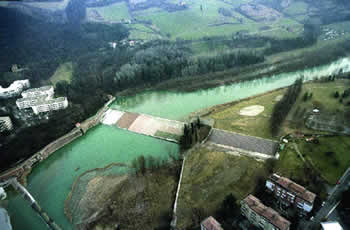Gone to the Beach!
by Paola Rubbi
Discovering the signs of a glorious past.
An exist from A1: if you come
from the South, the first in the plains, after the Appennines; the last pianura
padana before the mountains if you come from the North. Is there a specific
reason why a driver would want to leave the Autosole here in Casalecchio? The
most likely answer would be: I wouldn't know... But it is not the right answer
because Casalecchio di Reno, hinterland of Bologna now integrated in the
metropolitan city, is quite a vibrant place from ancient history, which bears
testimonies of a past that is not only famous, but industrious and also
lively.
If its name comes from the toponym given by the Romans  (Casaliculum, meaning
small centre), men chose way before then to establish themselves: close to the
wading on the Reno river in the community of Tripoli, the first permanent group
dates back to the period of Villanoviana, that is in the 7th century
B.C.
(Casaliculum, meaning
small centre), men chose way before then to establish themselves: close to the
wading on the Reno river in the community of Tripoli, the first permanent group
dates back to the period of Villanoviana, that is in the 7th century
B.C.
Etruscans and Gaulls inhabited the area; in the medieval times the
important monastery of S. Maria di Reno was built and the canons, in a feudal
system, demanded a toll for crossing the very ancient bridge. The story of this
structure, built in remote times, is weaved with destructions with each passing
war (and there have been so many) and reconstructions until it collapsed
following the terrible bombardments of 1944 and was reconstructed in
1947.
The very famous lock of Casalecchio had a better faith; it was built in
wood (probably by the canons of S. Maria di Reno) ten centuries ago with fine
technical criteria to deviate the water from the Reno in an artificial channel
meant to supply the industry (silk shops, mills, sawmills...), and
create navigation and irrigation for the city of Bologna.
The second
lock, in masonry, dates back to 1191 and there remains a lot of rubble; the
actual lock was built in 1360 and the water there is called Pelago.
From 800
on, Casalecchio became to be known as a place for holidays and pleasure: lovely
villas Liberty-style were built, and even if the shores of the river remained
unspoiled for a long time, the arrival of the steam tramway (June 5, 1883:
proceeds from tickets costing 25 cents each on inauguration day: 435 lire and 15
cents!) which linked Bologna to Casalecchio, followed by the electric tram,
created a continual entry of visitors even day commuters. People went to the
Reno to fish, hunt, swim in the summer and skate in the winter.
In 1933,
recall the historians from Casalecchio, the community decided to rationalize the
influx of visitors and made a beach, upstream of the lock, and entrusted its
management to the local association of war amputees. To access it, a regular
ticket had to be bought which gave the right to the rustic style commodities of
the beach establishment: a cared for bike storage, a double line of shelters, a
few tents, and rare beach umbrellas... There was even a friendly little
restaurant, managed by the Sandri family. It had a lot of success! Bathers came
from Bologna and from every town in the area. In the most splendid times, around
20,000 paying visitors came on Sundays. After the Second World War, it was a
well-known area, visited by young and older people from every social class who
had come out of the conflict with very little money and with so much desire to
live and have fun. Then came the boom: the river became more and more accessible
by transportation as much as economically, so around 1960 the beach area
declined and was gradually less frequented until a flood swept it away November
4th, 1966.
Casalecchio, with its many thousands of years of history, its
vestiges, the amenities of its landscape and the modernity of its urban
qualities, has therefore the right to be considered not only an exit of the
Autosole!